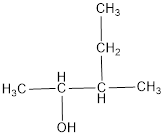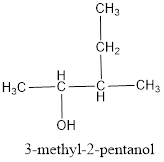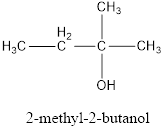
(a)
Interpretation:
Structural formula has to be written for the given alcohols and correct IUPAC name has to be assigned.
Concept Introduction:
The structural representation of organic compound can be done in 2D and 3D. In two-dimensional representation, there are four types of representation in which an organic compound can be drawn. They are,
- Expanded structural formula
- Condensed structural formula
- Skeletal structural formula
- Line-angle structural formula
Structural formula which shows all the atoms in a molecule along with all the bonds that is connecting the atoms present in the molecule is known as expanded structural formula.
Structural formula in which grouping of atoms are done and in which the central atoms along with the other atoms are connected to them are treated as group is known as Condensed structural formula.
Structural formula that shows the bonding between carbon atoms alone in the molecule ignoring the hydrogen atoms being shown explicitly is known as Skeletal structural formula.
Structural formula where a line represent carbon‑carbon bond and the carbon atom is considered to be present in each point and the end of lines is known as Line-angle structural formula.

IUPAC rules for naming alcohols that contain single hydroxyl group:
- Longest carbon chain has to be identified that contains hydroxyl group also. The chain name is obtained by replacing the letter “-e” in
alkane with “-ol”. - The numbering has to be given so that the hydroxyl group gets the least numbering.
- Name and location of any other substituent present in the chain has to be identified.
- If in a ring the hydroxyl group is present, then that carbon is numbered 1 and the numbering then proceeds counterclockwise or clockwise in a way that substituents present if any gets the least numbering.
- Hydroxyl group as a substituent in a molecule is named as hydroxy group rather than hydroxyl group.
IUPAC rules for naming alcohols that contain more than one hydroxyl group:
- The same rules said above is followed but the prefix di-, tri-, tetra etc is added corresponding to the number of hydroxyl groups that is present.
(a)
Answer to Problem 14.20EP
The structural formula is,

The correct IUPAC name of the given alcohol is 3-methyl-2-pentanol.
Explanation of Solution
Given name of alcohol is 3-ethyl-2-butanol.
From the name it is identified that the parent alkane is butane with a hydroxyl group on second carbon atom and an ethyl group on third carbon atom.

The structural formula for the given alcohol is drawn as shown above.
IUPAC name can be identified by finding the longest continuous carbon chain with the hydroxyl group. In this case it is found to be a five carbon chain and hence the parent is pentane. As the structure has a hydroxyl group in it, the suffix “-ol” has to be added instead of “-e” in the parent alkane. The numbering has to be given in a way that the hydroxyl group gets the least numbering. Looking for the substituent, a methyl group is present on the third carbon atom. This gives the IUPAC name of the alcohol as 3-methyl-2-pentanol as hydroxyl group is in the second carbon atom.

The structural formula for the given alcohol is drawn and correct IUPAC name is assigned.
(b)
Interpretation:
Structural formula has to be written for the given alcohols and correct IUPAC name has to be assigned.
Concept Introduction:
The structural representation of organic compound can be done in 2D and 3D. In two-dimensional representation, there are four types of representation in which an organic compound can be drawn. They are,
- Expanded structural formula
- Condensed structural formula
- Skeletal structural formula
- Line-angle structural formula
Structural formula which shows all the atoms in a molecule along with all the bonds that is connecting the atoms present in the molecule is known as Expanded structural formula.
Structural formula in which grouping of atoms are done and in which the central atoms along with the other atoms are connected to them are treated as group is known as Condensed structural formula.
Structural formula that shows the bonding between carbon atoms alone in the molecule ignoring the hydrogen atoms being shown explicitly is known as Skeletal structural formula.
Structural formula where a line represent carbon‑carbon bond and the carbon atom is considered to be present in each point and the end of lines is known as Line-angle structural formula.

IUPAC rules for naming alcohols that contain single hydroxyl group:
- Longest carbon chain has to be identified that contains hydroxyl group also. The chain name is obtained by replacing the letter “-e” in alkane with “-ol”.
- The numbering has to be given so that the hydroxyl group gets the least numbering.
- Name and location of any other substituent present in the chain has to be identified.
- If in a ring the hydroxyl group is present, then that carbon is numbered 1 and the numbering then proceeds counterclockwise or clockwise in a way that substituents present if any gets the least numbering.
- Hydroxyl group as a substituent in a molecule is named as hydroxy group rather than hydroxyl group.
IUPAC rules for naming alcohols that contain more than one hydroxyl group:
- The same rules said above is followed but the prefix di-, tri-, tetra etc is added corresponding to the number of hydroxyl groups that is present.
(b)
Answer to Problem 14.20EP
The structural formula is,

The correct IUPAC name of the given alcohol is 2,3-pentanediol.
Explanation of Solution
Given name of alcohol is 3,4-pentanediol.
From the name it is identified that there are two hydroxyl groups present each on third and fourth carbon atom of the parent alkane, pentane. The structure can be drawn as,

The structural formula for the given alcohol is drawn as shown above.
IUPAC name can be identified by finding the longest continuous carbon chain with the hydroxyl group. In this case it is found to be a five carbon chain and hence the parent is pentane. As the structure has two hydroxyl groups in it, the suffix “-

The structural formula for the given alcohol is drawn and correct IUPAC name is assigned.
(c)
Interpretation:
Structural formula has to be written for the given alcohols and correct IUPAC name has to be assigned.
Concept Introduction:
The structural representation of organic compound can be done in 2D and 3D. In two-dimensional representation, there are four types of representation in which an organic compound can be drawn. They are,
- Expanded structural formula
- Condensed structural formula
- Skeletal structural formula
- Line-angle structural formula
Structural formula which shows all the atoms in a molecule along with all the bonds that is connecting the atoms present in the molecule is known as Expanded structural formula.
Structural formula in which grouping of atoms are done and in which the central atoms along with the other atoms are connected to them are treated as group is known as Condensed structural formula.
Structural formula that shows the bonding between carbon atoms alone in the molecule ignoring the hydrogen atoms being shown explicitly is known as Skeletal structural formula.
Structural formula where a line represent carbon‑carbon bond and the carbon atom is considered to be present in each point and the end of lines is known as Line-angle structural formula.

IUPAC rules for naming alcohols that contain single hydroxyl group:
- Longest carbon chain has to be identified that contains hydroxyl group also. The chain name is obtained by replacing the letter “-e” in alkane with “-ol”.
- The numbering has to be given so that the hydroxyl group gets the least numbering.
- Name and location of any other substituent present in the chain has to be identified.
- If in a ring the hydroxyl group is present, then that carbon is numbered 1 and the numbering then proceeds counterclockwise or clockwise in a way that substituents present if any gets the least numbering.
- Hydroxyl group as a substituent in a molecule is named as hydroxy group rather than hydroxyl group.
IUPAC rules for naming alcohols that contain more than one hydroxyl group:
- The same rules said above is followed but the prefix di-, tri-, tetra etc is added corresponding to the number of hydroxyl groups that is present.
(c)
Answer to Problem 14.20EP
The structural formula is,

The correct IUPAC name of the given alcohol is 2-methyl-2-butanol.
Explanation of Solution
Given name of alcohol is 3-methyl-3-butanol.
From the name it is identified that the parent alkane is butane with a methyl group substituted in third carbon atom and a hydroxyl functional group on third carbon atom. The structure can be drawn as,

The structural formula for the given alcohol is drawn as shown above.
IUPAC name can be identified by finding the longest continuous carbon chain with the hydroxyl group. In this case it is found to be a four carbon chain and hence the parent is butane. As the structure has a hydroxyl group in it, the suffix “-ol” has to be added instead of “-e” in the parent alkane. The numbering has to be given in a way that the hydroxyl group gets the least numbering. Looking for the substituents, a methyl group is present in the second carbon atom. This gives the IUPAC name of the alcohol as 2-methyl-2-butanol as hydroxyl group is in the second carbon atom.

The structural formula for the given alcohol is drawn and correct IUPAC name is assigned.
(d)
Interpretation:
Structural formula has to be written for the given alcohols and correct IUPAC name has to be assigned.
Concept Introduction:
The structural representation of organic compound can be done in 2D and 3D. In two-dimensional representation, there are four types of representation in which an organic compound can be drawn. They are,
- Expanded structural formula
- Condensed structural formula
- Skeletal structural formula
- Line-angle structural formula
Structural formula which shows all the atoms in a molecule along with all the bonds that is connecting the atoms present in the molecule is known as Expanded structural formula.
Structural formula in which grouping of atoms are done and in which the central atoms along with the other atoms are connected to them are treated as group is known as Condensed structural formula.
Structural formula that shows the bonding between carbon atoms alone in the molecule ignoring the hydrogen atoms being shown explicitly is known as Skeletal structural formula.
Structural formula where a line represent carbon‑carbon bond and the carbon atom is considered to be present in each point and the end of lines is known as Line-angle structural formula.

IUPAC rules for naming alcohols that contain single hydroxyl group:
- Longest carbon chain has to be identified that contains hydroxyl group also. The chain name is obtained by replacing the letter “-e” in alkane with “-ol”.
- The numbering has to be given so that the hydroxyl group gets the least numbering.
- Name and location of any other substituent present in the chain has to be identified.
- If in a ring the hydroxyl group is present, then that carbon is numbered 1 and the numbering then proceeds counterclockwise or clockwise in a way that substituents present if any gets the least numbering.
- Hydroxyl group as a substituent in a molecule is named as hydroxy group rather than hydroxyl group.
IUPAC rules for naming alcohols that contain more than one hydroxyl group:
- The same rules said above is followed but the prefix di-, tri-, tetra etc is added corresponding to the number of hydroxyl groups that is present.
(d)
Answer to Problem 14.20EP
The structural formula is,

The correct IUPAC name of the given alcohol is 2-methyl-2-pentanol.
Explanation of Solution
Given name of alcohol is 1,1-dimethyl-1-butanol.
From the name it is identified that the parent alkane is butane with a hydroxyl group at first carbon atom and two methyl groups as substituents in first carbon atom. The structure can be drawn as,

The structural formula for the given alcohol is drawn as shown above.
IUPAC name can be identified by finding the longest continuous carbon chain with the hydroxyl group. In this case it is found to be a five carbon chain and hence the parent is pentane. As the structure has a hydroxyl group in it, the suffix “-ol” has to be added. The numbering has to be given in a way that the hydroxyl group gets the least numbering. Looking for the substituents it is identified that a methyl group is present on second carbon atom. This gives the IUPAC name of the alcohol as 2-methyl-2-pentanol as hydroxyl group is in the second carbon atom.

The structural formula for the given alcohol is drawn and correct IUPAC name is assigned.
Want to see more full solutions like this?
Chapter 14 Solutions
EBK GENERAL, ORGANIC, AND BIOLOGICAL CH
- Define the following terms: a. reducing sugar b. alditol c. enediol d. acetal e. ketalarrow_forwardWhy do you think compounds containing the heavy metal lead are poisonous?arrow_forwardDraw a structural formula for each compound. (a) trans-2-Methyl-3-hexene(b) 2-Methyl-3-hexyne(c) 2-Methyl-1-butene (d) 3-Ethyl-3-methyl-1-pentyne (e) 2,3-Dimethyl-2-pentenearrow_forward
- Draw a Lewis structure for hydroxylamine, NH2OH.arrow_forwardThe components of poison ivy and poison oak that produce the characteristic itchy rash are catechols substituted with long-chain alkylgroups. If you were exposed to poison ivy, which of the treatments below would you apply to the affected area? Justify your choice.(a) Wash the area with cold water.(b) Wash the area with dilute vinegar or lemon juice.(c) Wash the area with soap and water.(d) Wash the area with soap, water, and baking soda (sodium bicarbonate).arrow_forwardThe compounds 1-hexanol, 3-methyl-3-pentanol, hexanal, and 2-hexanone, and were used using different tests. Shown below is the schematic diagram of the tests performed on the compounds. Determine the identities of each compound based on the tests performed. a.) Compound A b.) Compound B c.) Compound C d.) Compound D Choices: I. 1-hexanol II. hexanal III. 2-hexanone IV. 3-methyl-3-pentanoarrow_forward
 Human Anatomy & Physiology (11th Edition)BiologyISBN:9780134580999Author:Elaine N. Marieb, Katja N. HoehnPublisher:PEARSON
Human Anatomy & Physiology (11th Edition)BiologyISBN:9780134580999Author:Elaine N. Marieb, Katja N. HoehnPublisher:PEARSON Biology 2eBiologyISBN:9781947172517Author:Matthew Douglas, Jung Choi, Mary Ann ClarkPublisher:OpenStax
Biology 2eBiologyISBN:9781947172517Author:Matthew Douglas, Jung Choi, Mary Ann ClarkPublisher:OpenStax Anatomy & PhysiologyBiologyISBN:9781259398629Author:McKinley, Michael P., O'loughlin, Valerie Dean, Bidle, Theresa StouterPublisher:Mcgraw Hill Education,
Anatomy & PhysiologyBiologyISBN:9781259398629Author:McKinley, Michael P., O'loughlin, Valerie Dean, Bidle, Theresa StouterPublisher:Mcgraw Hill Education, Molecular Biology of the Cell (Sixth Edition)BiologyISBN:9780815344322Author:Bruce Alberts, Alexander D. Johnson, Julian Lewis, David Morgan, Martin Raff, Keith Roberts, Peter WalterPublisher:W. W. Norton & Company
Molecular Biology of the Cell (Sixth Edition)BiologyISBN:9780815344322Author:Bruce Alberts, Alexander D. Johnson, Julian Lewis, David Morgan, Martin Raff, Keith Roberts, Peter WalterPublisher:W. W. Norton & Company Laboratory Manual For Human Anatomy & PhysiologyBiologyISBN:9781260159363Author:Martin, Terry R., Prentice-craver, CynthiaPublisher:McGraw-Hill Publishing Co.
Laboratory Manual For Human Anatomy & PhysiologyBiologyISBN:9781260159363Author:Martin, Terry R., Prentice-craver, CynthiaPublisher:McGraw-Hill Publishing Co. Inquiry Into Life (16th Edition)BiologyISBN:9781260231700Author:Sylvia S. Mader, Michael WindelspechtPublisher:McGraw Hill Education
Inquiry Into Life (16th Edition)BiologyISBN:9781260231700Author:Sylvia S. Mader, Michael WindelspechtPublisher:McGraw Hill Education





